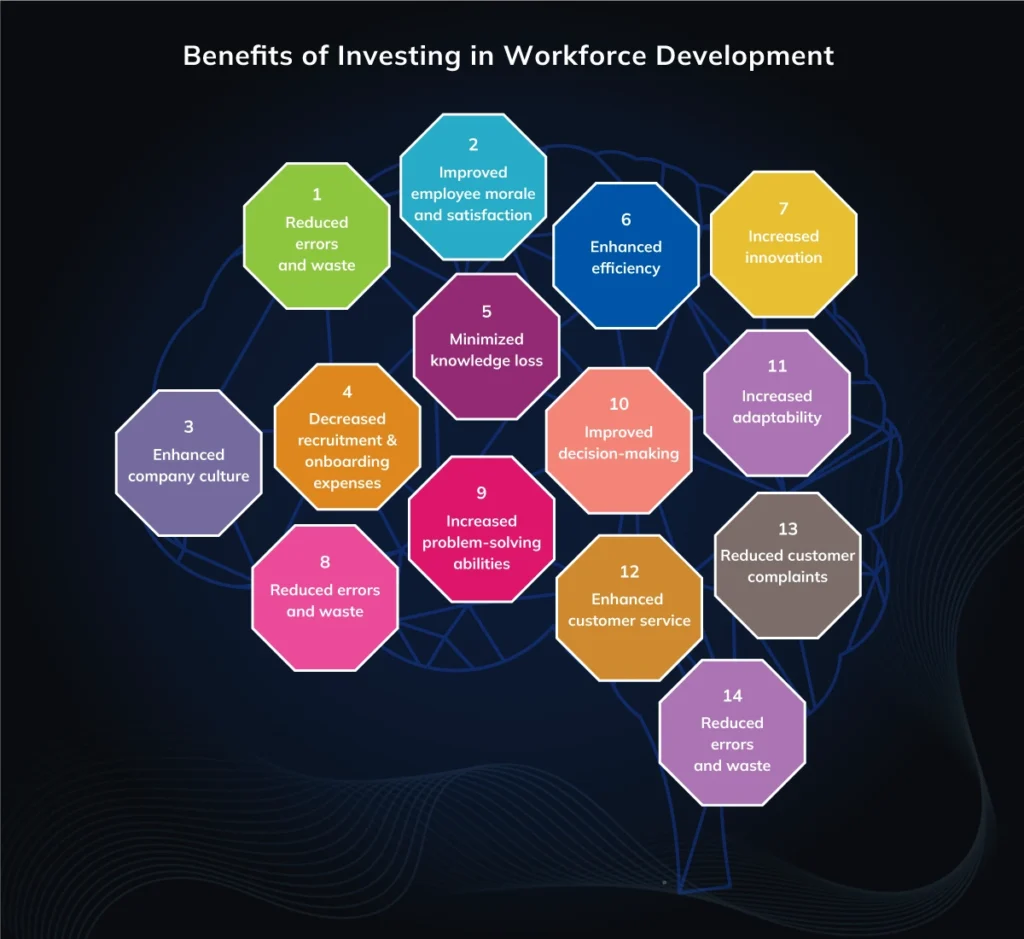What is Workforce Development?
Workforce development is a comprehensive approach to training, education, and career development for your employees. It encompasses many activities, from onboarding new hires to providing ongoing learning and skill development opportunities. The goal of workforce development is to ensure your employees have the necessary skills and knowledge to perform their jobs effectively and adapt to changing business needs.
Workforce development is a comprehensive approach to training, education, and career development for your employees.
It encompasses many activities, from onboarding new hires to providing ongoing learning and skill development opportunities.
Impact of Workforce Development on the Organization
Investing in workforce development can profoundly impact an organization’s overall success. Here are some key areas where it can benefit the organization:
Impact of Workforce Development on the Organization
Improved Organizational Performance
Stronger Company Culture
Enhanced Sustainability
Improved Organizational Performance
- Increased profitability: Workforce development can directly contribute to increased profitability by improving employee productivity, reducing turnover costs, and enhancing innovation.
- Enhanced competitive advantage: Organizations that invest in workforce development can gain a competitive edge by having a skilled and motivated workforce.
- Improved organizational agility: A well-developed workforce is better equipped to adapt to changing business conditions, enabling organizations to remain agile and responsive.
Stronger Company Culture
- Increased employee engagement: Employees who feel valued and have growth opportunities are likelier to be engaged in their work. This can contribute to a positive and supportive company culture.
- Improved employee morale: A culture of learning and development can boost employee morale and create a sense of belonging.
- Enhanced reputation: A company with a strong culture of learning and development can attract and retain top talent, improving its reputation in the marketplace.
Enhanced Sustainability
- Future-proofing the organization: By investing in workforce development, organizations can ensure their employees have the skills and knowledge they need to succeed. This can help to future-proof the organization and ensure its long-term sustainability.
- Reduced environmental impact: A skilled and well-developed workforce can be more efficient and less wasteful, reducing the organization’s environmental impact.
- Social responsibility: Investing in workforce development is a socially responsible practice, as it helps create opportunities for employees and contribute to the community’s overall well-being.
Here’s How Investing in Workforce Development Leads to Long-Term Cost Savings
Increased Employee Retention
- Reduced turnover costs: Replacing an employee can be significant, ranging from one-half to twice their annual salary. By investing in workforce development, organizations can create a more engaged and motivated workforce, reducing turnover and associated costs.
- Improved employee morale and satisfaction: Employees who feel valued and have growth opportunities are more likely to be satisfied with their jobs. This can lead to increased morale, reduced absenteeism, and higher productivity.
- Enhanced company culture: A culture of learning and development can attract and retain top talent, contributing to a positive and productive work environment.
Reduced Turnover Costs
- Decreased recruitment and onboarding expenses: High turnover rates can increase the costs of recruiting and onboarding new employees. By investing in workforce development, organizations can reduce the need to fill vacancies constantly.
- Minimized knowledge loss: When employees leave, they take their knowledge and experience with them. By investing in workforce development, organizations can ensure that employees have the skills and knowledge they need to succeed, reducing the risk of knowledge loss.
Improved Productivity
- Enhanced efficiency: Well-trained employees with the necessary skills are more likely to be efficient in their roles. This can lead to increased productivity and reduced costs.
- Increased innovation: A skilled and well-developed workforce is likelier to be innovative and generate new ideas. This can improve products, services, and processes, saving costs.
- Reduced errors and waste: Employees with the skills and knowledge to perform their jobs effectively are less likely to make mistakes or waste resources.
Enhanced Innovation
- Increased problem-solving abilities: Employees with the necessary skills can better identify and solve problems. This can lead to improved efficiency and reduced costs.
- Improved decision-making: A well-developed workforce will likely make informed and effective decisions. This can help organizations avoid costly mistakes.
- Increased adaptability: Employees constantly learning and developing new skills are better equipped to adapt to changing business conditions. This can help organizations stay competitive and avoid costly disruptions.
Improved Customer Satisfaction
- Enhanced customer service: Well-trained and knowledgeable employees can better provide excellent customer service, increasing customer satisfaction and loyalty.
- Reduced customer complaints: When employees have the skills and knowledge to resolve customer issues effectively, customer complaints and associated costs can be reduced.
- Improved brand reputation: Satisfied customers are likelier to recommend a company to others. By investing in workforce development, organizations can improve their brand reputation and attract new customers.
Spire.AI: Your AI Copilot for Workforce Development and Cost Savings
Spire.AI is an AI-powered platform designed to help organizations revolutionize their talent management strategies and achieve significant cost savings through effective workforce development. Spire.AI’s suite of solutions empowers companies to:
- Build a Skills-Based Organization: Spire.AI uses intelligent automation to create an auto-evolving role-skill framework. This framework identifies the skills required for every role in your organization, allowing you to develop targeted workforce development programs.
- Develop Personalized Learning Plans: Spire.AI utilizes AI to generate employee skill profiles based on various data sources. This allows you to identify skill gaps and provide each employee with a personalized learning plan that aligns with their career aspirations and the organization’s needs.
- Increase Internal Mobility: Spire.AI’s talent marketplace connects employees with internal opportunities that match their skill sets. This reduces reliance on external recruitment and boosts employee engagement by providing growth opportunities within the organization.
- Reduce Time-to-Hire: Spire.AI’s AI-powered talent acquisition module streamlines the recruitment process by automatically matching job descriptions with qualified candidates based on their skills. This reduces time-to-hire and associated costs.
Implementing a workforce development strategy powered by Spire.AI can unlock significant cost savings and propel your organization toward long-term success.
Conclusion
In today’s competitive and rapidly evolving business landscape, investing in workforce development is no longer a luxury but a strategic imperative. Organizations can reap significant benefits by equipping employees with the skills and knowledge they need to succeed, including increased employee retention, reduced turnover costs, improved productivity, enhanced innovation, and improved customer satisfaction.
Moreover, workforce development can profoundly impact an organization’s overall performance, company culture, and sustainability. By creating a culture of learning and development, organizations can attract and retain top talent, improve employee engagement, and foster a sense of belonging. Investing in workforce development can help organizations remain competitive, adapt to changing business conditions, and contribute to a more sustainable future.
Spire.AI is a powerful tool that helps organizations achieve their workforce development goals. By providing AI-powered solutions for talent management, Spire.AI can help organizations identify skill gaps, develop personalized learning plans, and streamline recruitment processes. This can lead to significant cost savings and improved organizational performance.
In conclusion, investing in workforce development is wise for any organization that wants to remain competitive and successful. Empowering employees with the skills and knowledge they need to succeed can create a more engaged, productive, and innovative workforce, ultimately driving long-term growth and profitability.







